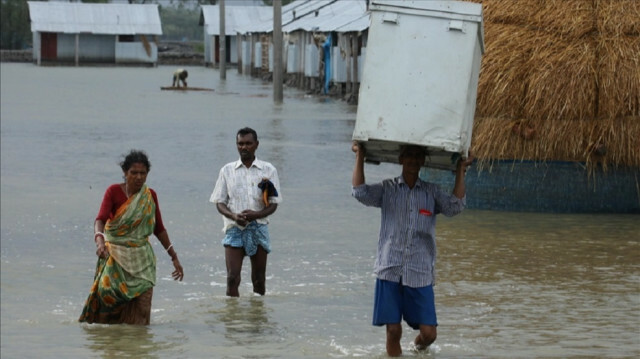
Two dead, many areas inundated, cattle swept away by tidal surge spawned by Cyclone Yaas, says state minister
Powerful Cyclone Yaas battered Bangladesh on Wednesday, affecting 27 subdistricts of nine southern coastal districts, according to official sources.
Most of the impacted areas were inundated by a tidal surge spawned by the cyclone that affected croplands, homes, roads, bridges and cattle, said a statement issued by the country's Disaster Management and Relief Ministry.
At a press briefing late Wednesday, however, State Minister Md Enamur Rahman said the country is now out of danger.
"Bangladesh is now fully out of the impacts of Cyclone Yaas," Rahman said, adding 76,000 volunteers along with members of the Bangladesh Scouts, Red Crescent Society and Ansar VDP, a paramilitary auxiliary force, were prepared to serve people.
Regular police forces also monitored disciplinary measures at all cyclone shelters, where people were given sufficient amounts of hand sanitizer and facemasks to contain the spread of the coronavirus pandemic.
“As the severe cyclone did not hit Bangladesh heavily, most of the people left the cyclone shelters by Wednesday night,” he added.
According to preliminary records collected from the affected areas by the ministry, as of Wednesday evening, 12 fish firms and several hectares of croplands had been submerged in the southern district of Pirojpur, while 250 homes were damaged and nearly 900 cattle were washed away in the island district of Bhola. In addition, the cyclone left 21 villages under flood water in Bagerhat district, affecting thousands of people, and in other areas, roads and bridges were damaged.
A man was also killed after being hit by a falling tree during gusty weather late Tuesday while a fisherman died Tuesday after his boat capsized in the sea amid the rough weather due to the impact of the cyclone, according to official sources.
The South Asian delta nation has frequently experienced natural disasters for decades as it is also one of the world's most affected countries from climate change.
In the last five decades, nearly half a million people in Bangladesh have died from more than a dozen cyclones, according to official records.
Following the extremely severe Cyclone Sidr in 2007, Bangladeshi authorities have constructed many cyclone shelters and developed other settlements to contain the damage from natural disasters, resulting in comparatively fewer casualties from natural calamities.
In May last year, 31 people in Bangladesh died from Cyclone Amphan, which also hit parts of neighboring India.
Rohingya on remote island unaffected
Meanwhile, 20,000 Rohingya on a remote Bangladeshi island in the southern Bay of Bengal were not affected by the cyclone.
But due to its impact, water levels rose, and many Rohingya were seen catching fish in the water.
The persecuted people, who were relocated there, also took refuge at cyclone shelters which double as learning centers under an island project.
The Bangladeshi government has constructed 1,400 big cluster houses four feet above the ground with concrete blocks and 120 multi-storied cyclone shelters on the island. Each cluster house is made up of 16 rooms.
Spending over $350 million from its domestic resources, the Muslim-majority country has developed a resettlement project on 13,000 acres for temporarily resettling 100,000 Rohingya Muslims.
According to official sources, the silt island, located 50 kilometers (31 miles) off Bangladesh’s southwestern coast and nearly 193 kilometers [120 miles] south of the capital Dhaka, remains disconnected from the mainland and any potential assistance during natural disasters.

